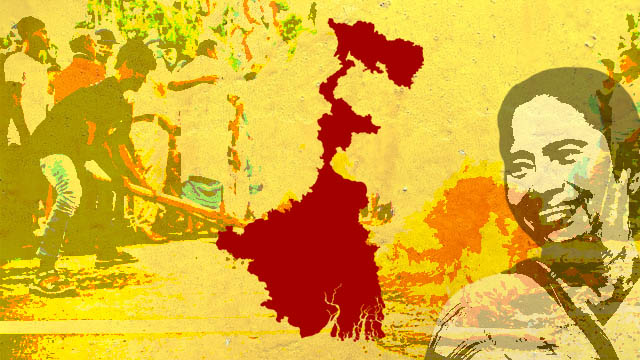Panchayat elections in West Bengal have always been an event of tremendous anticipation and an apparent reflection of a change in the political litmus of the state. The first clear indication of the changing political scenario of West Bengal has ever been reflected through panchayat elections.
The mandate of the people brought about through grassroots elections has seldom been free of violence and poll manipulations. For instance, in the 2018 panchayat elections in West Bengal, 34% of the gram panchayat seats reportedly went uncontested. The figure was thrice the 11% seats won uncontested by the ruling Left Front, led by the Communist Party of India (Marxist) [CPI(M)], during the 2003 panchayat elections.
The panchayat elections in West Bengal could be reflective of the undercurrents of democracy at the grassroots. However, people on the ground think otherwise. We spoke to certain resident voters in Nafarganj village in the Sundarbans, located at a distance of 90km from the capital city of Kolkata, to assess the issues affecting rural West Bengal.
“If panchayat elections are left untampered, BJP (Bharatiya Janata Party) may win with a good margin this time”, said Gopal Biswas (name changed), a man in his 50s. We met him by the bank of the Matla River, just a few yards away from his shanty where he welcomingly invited us in.
A farmer by profession, he spoke by and large about the state of agriculture, wage labour and welfare in the village, marred with a high state of corruption in the gram panchayat and panchayat samiti in his own as well as neighbouring villages. His comment on the panchayat elections in West Bengal was more of a satire than a desire.
“The ruling party (Trinamool Congress or TMC) exercises bureaucratic control over the agricultural land. Last year, they took over my land, arbitrarily reaped the harvest and I was left with nothing”, Biswas said.
He mentioned that nobody in the village has been given documents of ownership of the agrarian property even when the land reforms took place under the erstwhile Left Front government. Thus, with every subsequent shift in the local and state government, the bureaucratic control of the land shifts. It is redistributed to the people in the good books of the local government while the actual owners, who in most cases are ostracised Dalits and tribals, are evicted from their lands.
The celebration of democracy at the grassroots has been a bloody phenomenon. Death is a common consequence. As per statistics, 76 people were killed during the 2003 panchayat elections under the reign of the CPI(M). In the subsequent panchayat elections in 2008, 2013 and 2018, the death toll stood at 36, 39 and 29 respectively. Even as the results unfold this year, the death count has already reached 45 unofficially and fresh incidents of violence continue to erupt throughout restive parts of West Bengal.
Speaking about the apparent corruption regarding the Pradhan Mantri Awaas Yojana – Gramin [PMAY(G)], our interviewee said, “Cut money is the norm here. It ranges from Rs 10,000 to Rs 15,000 for PMAY (G) application.” However, he mentioned that many in the village have not received the benefit of the scheme despite having paid the “cut money.” Funds for PMAY(G) have gone into the accounts of those in the good books of the local leaders of the TMC; most of them are ineligible to receive benefits under the scheme for already having pucca houses.
As the conversation progressed, we were told that Mahatma Gandhi National Rural Employment Guarantee Act (MGNREGA) jobs in the village are an open eye-wash. “MGNREGA job cards of a chunk of villagers are put up on the muster rolls while the actual lake restoration work is either not done at all or is done through JCB.” He also mentioned how the direct transfers in the account of the job card holders are threateningly extracted from them.
“The wage in the area for a day’s work is Rs 400; the goons of the local TMC leaders take Rs 300 and let the individual keep the rest”, he mentioned.
The resident villagers express their discontent over the corrupt policies of the panchayat samitis regarding the sale of grains at lower than the minimum support price (MSP) announced by the government.
The panchayat samitis are empowered to buy crops directly from the farmers at the MSP, which is fixed at Rs 2,060 per quintal of paddy. However, as per the testimony of the villagers, the panchayat samiti at their block offers only Rs 1,400 for every bag of paddy to the farmers they buy directly from, which does not exceed more than a select few farmers. The majority of the farmers are forced to sell their produce to usurers who offer Rs 800 to Rs 900 per bag of paddy.
The panchayat samiti is accused of foul play to ensure that the chain of agrarian intermediaries remains in demand for which the local leaders receive a “cut” themselves. “We are barely able to meet the cost of production because of the systematic practice”, Biswas said.
The system in rural West Bengal paints a clear picture of deterministic and rigid systematic corruption and exploitation which is seemingly immune to parliamentary changes. The growing instances of violence during panchayat elections in West Bengal are intrinsically connected with the corruption that the panchayat system begets, as rural unemployment skyrockets and farmers fail to earn profit from their crops.
Debjani is a social activist and student of law. She talks all about politics, philosophy, law and current affairs.

